Design and Realization of an NFC-Driven Smart Home System to Support Intruder Detection and Social Network Integration
2015-11-18JenJeeChenZhengXunJiangYueLiangChenWenTaiWuandJiaMingLiang
Jen-Jee Chen, Zheng-Xun Jiang, Yue-Liang Chen, Wen-Tai Wu, and Jia-Ming Liang
Design and Realization of an NFC-Driven Smart Home System to Support Intruder Detection and Social Network Integration
Jen-Jee Chen, Zheng-Xun Jiang, Yue-Liang Chen, Wen-Tai Wu, and Jia-Ming Liang
—The Internet of thing (IoT) emerges as a possible solution to realize a smart life in the modern age. In this article, we design and realize a novel near field communication (NFC)-driven smart home system for IoT, which integrates the wireless sensor network(WSN), social networks, and the cloud computing. NFC technology provides a way for users to exchange information between them and the system by simply contacting. So, we propose to use NFC as the system drive in the architecture, such that users can intuitively interact with the system and deliver their intentions. Then, the corresponding service over the system will control or adjust the “things” at home to fit users’ needs. Furthermore, the proposed system provides a platform for developers to easily and rapidly implement their smart home related services. In the system, WSN sensing and control, NFC communications and identification, user profile management and preference analysis, and social network integration are all provided as platform services. We will show how the system works for home automation, intruder detection, and social network sharing.
Index Terms—Cloud computing, home automation,intruder detection, near field communication, security monitoring, social networks, wireless sensor network.
1. Introduction
The Internet of thing (IoT) is an emerging concept, in which every object is allowed to connect to each other and access the Internet via wireless/wireline sensor/local/ wide-area networks. Home automation[1]is one of the most attractive IoT applications. To enable home automation, a future smart home will be embedded in various and large quantities of sensors and actuators. Consumer electronics and 3C (computer, communication, and control) products must be self-configurable and remotely controllable through the Internet[2]. These devices sense and record users’activities, predict their future behaviors, and then prepare everything one step ahead according to each of their preference and needs, giving them the most convenient,comfortable, efficient, and secure living environment.
People’s needs change at different time and for different activities. Therefore, some studies[3]suggest allowing users setting their own preferences, and then the system regulates the environment accordingly. But this approach ignores the user activity information. Even at the same room or space,users have different requirements for different ongoing activities. To solve this problem, on the other hand, some studies[4]propose to detect users’ behaviors according to the order of appliances used, and then regulate the environment according to the detecting results. But the detection error is hard to avoid. So, in this paper, we propose a near field communication (NFC)-driven smart home system. Via NFC,users are allowed to provide their behavior/activity information to the system by simply contacting. The NFC in our system gives users an intuitive way to exchange information and instructions with the system. Then the system can control and adjust the environment in accordance of users’ behavior and preferences effectively. This style of interaction can be applied to many customized smart services.
In addition to NFC, the proposed system integrates with the wireless sensor networks (WSNs), social networks, and the clouding computing to help realize smart home. WSNs sense the environmental information of every place and every corner of the home and then collect the data in the sink (or coordinator). The cloud server can regulate appliances and consumer electronics based on the user’s activity, personal preferences, and the collectedenvironmental status. Note that for traditional appliances,which do not have microchips inside and cannot connect to the Internet, we design a smart plug and a sensing and control circuit board (SCB) for them. By embedding with the SCB or connecting to the smart plug, the appliances then become intelligent consumer electronics. Thus all kinds of devices and appliances can join the smart home network. Combining with social networks (currently, we integrate the system with Facebook (FB)), the system can be regarded as a cyber-physical system[5]. In this system,the WSN senses and reports the physical information of home environment, the cloud server hosts these records and the status of appliances and their power consumption. Users can share the physical information on the virtual community network. This not only increases the real life sharing and exchanges among friends and families, but also lets users review their lives and learn other people’s good life styles and habits. Above social network sharing is one of the services we implement by using our NFC-driven smart home system. Home automation and intruder detection are the other two services we will introduce in this paper. For the intruder detection, we exploit the existing infrared sensor and wireless signals in the WSN to detect whether an intruder enters the house as the users leave their home. If this occurs, the system will immediately notify the users to check the web camera(s)and deal with it. In the following, we will illustrate the system in more detail and introduce the three services,home automation, social network sharing, and intruder detection, developed by using the proposed system.
The rest of this paper is organized as follows. Section 2 introduces the NFC-driven smart home system architecture. Section 3 presents the home automation, social network sharing, and intruder detection applications. Section 4 concludes this paper.
2. NFC-Driven Smart Home System Architecture
The use scenario for the proposed NFC-driven home automation architecture is shown in Fig. 1. The architecture is composed of the following 6 subsystems.

Fig. 1. Scenario of NFC-driven smart home architecture.
2.1 Home Automation Subsystem (HAS)
We have developed the sensing and control circuit board (SCB) which is equipped with several kinds of sensors, such as temperature-humidity sensor, light sensor,gyro, and G sensor, the relay and wireless communication modules, such as ZigBee and Bluetooth. With SCBs, a system can monitor the environment by deploying them in the space, or record the movement and status of users by allowing users to assemble them. Moreover, SCBs can be embedded on the traditional appliances or 3C products to realize remote control according to users’ preferences or environmental conditions.
2.2 NFC-Based Interaction Subsystem (NIS)
To increase users’ convenience, NFC is used as the interaction interface between users and the system. NIS provides two major functions, identity identification and system control mode switching. In terms of identity identification, users are allowed to use the smartphone or NFC tag to identify each of them. At the entrance of each independent space, an NFC reader will be installed to recognize the identity of users. In terms of system control mode switching, on the other hand, a set of NFC tags are imparted different meanings, such as “go out”, “go back home”, and “home security”. Instead of a series complicated settings on the phone or computer, users can easily change the working mode of the system by simply contacting the corresponding NFC tag with the smartphone or NFC reader.
2.3 WSN
SCBs deployed in the space can interconnect each other via the ZigBee wireless module and form a WSN. Through the network, the sensing environmental information, such as temperature, humidity, and light intensity, and the control messages, such as turning on the TV and opening up the reading lamp, can be forwarded to the central cloud platform and the corresponding appliances, respectively.
2.4 Cloud Platform Subsystem (CPS)
We have built and developed a cloud platform, which works as the central controller of the whole system. The cloud platform records and analyzes the digitalized physical information collected from the WSN and NFC readers. According to users’ identity and preference, the cloud platform controls the appliances and 3C products to maintain a comfortable living environment for users. The cloud platform allows users and developers to define or develop new services over the platform by exploiting the web API and collected data in the database. For example,users’ identity identification and control mode switching are implemented as services in the platform.
2.5 Social Network Integration Subsystem (SIS)
We have integrated our system with one of the most popular social networks, FB. To achieve this, a user use his/her FB account as the system account. This allows users to share their data recorded in the cloud platform. Thecloud platform can plot charts using the logged data according to users’ requests, such as users’ daily movement and energy consumption of the house or certain appliance over a period of time. Furthermore, users’ social connections may be used as a reference to improve the correctness of decision making.
2.6 Home Security Subsystem (HSS)
HSS is implemented over the cloud platform. Here we use infrared sensor devices and observe the wireless signal variation of existing SCBs in the WSN to detect whether there is any intruder entering the house. If the intruder exists, HSS will notify the user through the cloud platform. Upon receiving the notification, the user can view the situation of the house/home via the security cameras in real-time.
3. Home Automation, Social Network Sharing, and Intruder Detection
3.1 Home Automation and Social Network Sharing
The application includes the hardware design and control, user interface development, and core network cloud server connectivity. The whole application can be divided into four parts. In the following, we will introduce them separately.
A. SCB and WSN
The designed SCB is shown as Fig. 2, which is equipped with Jennic5148[7], light sensor (TSL2561),temperature and humidity sensor (SHT21), relay, and ten-axis sensor.
We design the SCB by using OrCAD and Pads. The sensing data is passed to Jennic5148 via I2C(inter-integrated circuit). Jennic5148 then uploads the data to the cloud server periodically or when being queried (via built in IEEE 802.15.4). SCB can control the switch and strength of appliances or 3C products by changing the DIO(digital input and output) input signal level. SCB is programed by using the Jennic SDK (software development kit) and libraries and the development environment is eclipse. We can embed our developed SCBs into the traditional consumer electronics and then they will become intelligent and network enabled appliances. The intelligent appliances and the SCBs deployed in the house form a WSN via ZigBee network protocol. Central to the WSN is the SCB called coordinator. All sensing data from SCBs are collected in the cloud server via the coordinator. On receiving the sensing data, the cloud server will control the appliances and 3C products according to users’ preference or report events to the upper layer service when some predefined conditions fit. Fig. 3 shows our designed smart plug[8]. For a traditional home appliance, plugging in the plug socket on the smart plug makes it become an intelligent consumer electronic. Users can remotely control and monitor the status of the smart appliance via the control circuit of the smart plug. Therefore, all appliances may join the WSN no matter they are modern consumer electronics or traditional appliances.

Fig. 2. Sensing and control circuit board (SCB): (a) front and (b)back.
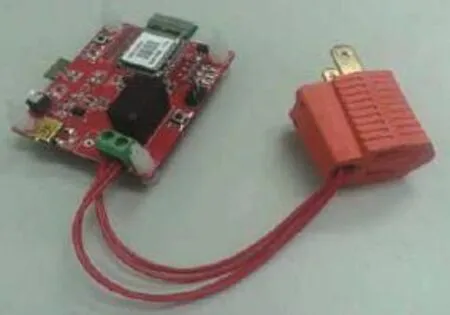
Fig. 3. Smart plug.
B. NFC-Based Interaction Subsystem (NIS)
We define NFC tags with different meanings (or represent different system modes), such as “go out”, “go back home”, and “home security”. We have written an Android App which is responsible for interacting with NFC tags and sending mode switching messages back to the cloud platform. For example, once the “go back home”NFC tag is used, the “go back home” mode will be activated and the home automation service will slowly turn on all the required home appliances or 3C products in sequence to create a comfortable environment according to the users’ preference before he/she arrive home. NFC allows users to easily and intuitively interact with the system. This idea can be applied to many applications more than home automation, such as “elderly care”.
C. Home Automation Serνice
Users’ intentions are input from NIS while the environmental information is always monitored by the WSN. According to the users’ input and the sensing data,the home automation service in the cloud server can analyze them and derive the control strategy by exploiting the personal preference analysis module. Then the home automation service carries out the control commends by calling the APIs provided by the control module. On receiving the requests, the control module translates and sends these commends to the corresponding appliances and 3C products. Fig. 4 shows the smart appliances we made.D. User Interface and Social Network Sharing

Fig. 4. Smart appliances.
All sensing data is logged and stored in the cloud server. For the user interface, in the front-end, we use HTML5 and CSS3; in the back-end, we use node.js[9].
The user interface over different user devices are shown in Fig. 5. Users can use either a personal computer or a handheld device to access the smart life services. Via the interface, users can set their preferences or control the appliances directly. Moreover, users can view the logged data at any time. For example, Fig. 5 (b) shows the proportion of energy consumption of each appliance. Reviewing that the chart plot module can query and analyze the logged data, the social network sharing service allows users to share these logged information and statistical data on FB (as shown in Fig. 6 and Fig. 7). This increases users’real life sharing and exchanges among friends and families. In addition, users can review their lives and learn other people’s good life styles and habits. Furthermore, for applications like elderly care, this social network sharing allows family members to check the environment, such as temperature and humidity, and the usage of appliances and electronics.
The first two parts, WSN and NIS, of the home automation and social network sharing application are already integrated in the NFC-driven smart home system and modulized. The last two parts are implemented as services on the top of the cloud server.
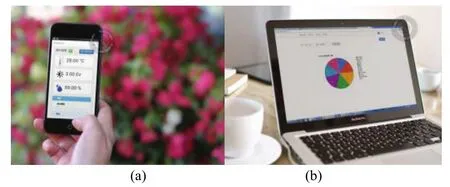
Fig. 5. Smart Life interface.

Fig. 6. Example of social networking sharing in our system: share a link on facebook.
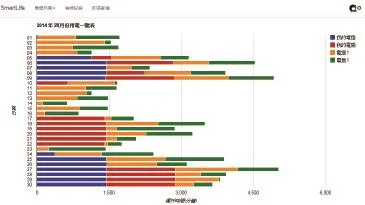
Fig. 7. Example of social networking sharing in our system: share statistical data.
3.2 Intruder Detection
The intruder detection service is activated when users switch the system into the “go out” mode. The intruder detection service employs infrared (IR) sensing devices and the changes of existing IEEE 802.15.4 wireless signals to detect whether an intruder breaks into the home. Once intruders are detected, the system will immediately send a notification to the users, as shown in Fig. 8. Users then can connect to the Internet/security camera and do remote monitoring, as shown in Fig. 9.

Fig. 8. Intruder notification letter.

Fig. 9. Real time video surveillance via the smart life interface.
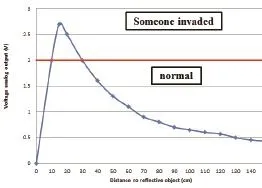
Fig. 10. Effect of distance on the voltage analog output for IR sensor.
To realize the intruder detect service, we have implemented an infrared (IR) distance monitoring device to detect whether there is any unknown person entering home when the intruder detect service is activated. Fig. 10 shows the effect of distance on the voltage analog output of the IR distance monitoring device. According to the real testing,the voltage change for the distance between 0 cm to 90 cm is able to be clearly identified. On the other hand, the received IEEE 802.15.4 wireless signal strength can also be used to detect intruders. In theory, as long as there is an invader in the space, the received signal will immediately change because of the obstacle. But wireless signals drift time to time, we have to carefully determine whether the signal change is an intruder or just a drift. Fig. 11 shows the LQI change of the received IEEE 802.15.4 wireless signals in different cases. Fig. 12 shows the settings of the experiment. According to the experimental results, we can detect whether an intruder breaks into the system environment. Once the system informs the users that an invasion happens, they can connect to Internet cameras to check the situation at home.
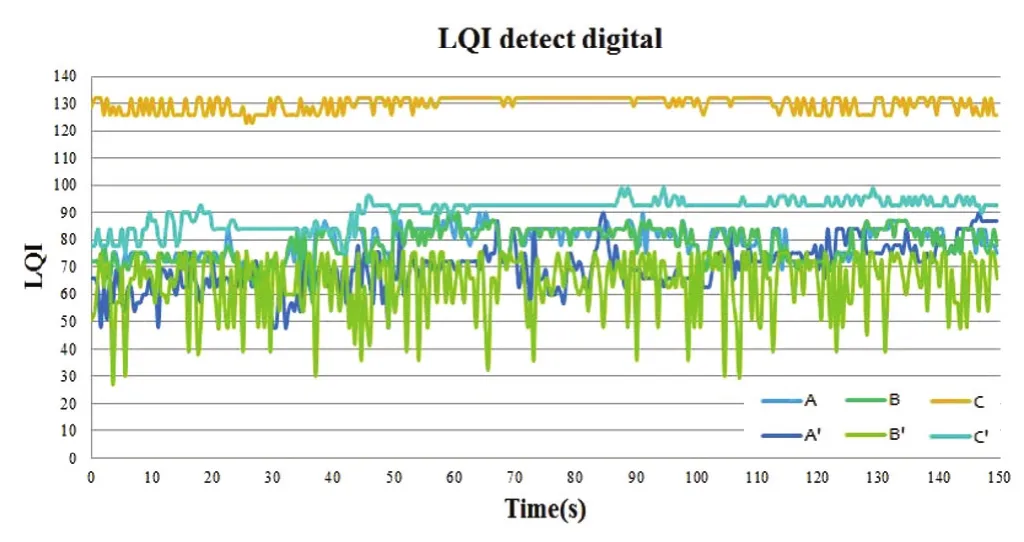
Fig. 11. LQIs of the received signals from A, B, and C.
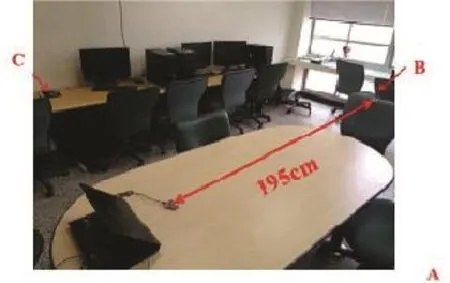
Fig. 12. Settings of the experiment. (Three SCBs A, B, and C are placed at the positions as shown in the figure.)
To prevent errors (after measurement, there are still significant signals drift), we propose to observe the sliding window voltage output mean and standard deviation as given in (1), (2), and (3):


where W is the size of the sliding window and x[t] is the sample of voltage analog output at time t. Note that if t<W,then W=t. The observed interference of the experimental results can be completely filtered by using (1), (2), and (3).
4. Conclusions
In this paper, we design an NFC-driven smart home system which integrates WSNs, social networks, and the cloud computing. Users are allowed to use NFC technology easily interacting with the system. The entire system is quite complete. As examples, we implement 3 services over the proposed system: home automation, social network sharing, and intruder detection. These allow users to enjoy a more humane, convenient, and secure life. Intruder detection is always a critical issue for home safety. Here we integrate IR, IEEE 802.15.4 wireless signals, and Internet camera to propose a complete solution, which significantly reduces both the false positive and false negative rates. Our system can help developers to easily and rapidly implement their smart home related services. In the future, we will extend services to elderly care and provide more useful modules in the system.
[1] J. Huang and X. Ye, “A framework for cloud-based smart home,” in Proc. Int. Conf. on Computer Science and Network Technology, 2011, pp. 894-897.
[2] J.-Y. Son, J.-H. Park, K.-D. Moon, and Y.-H. Lee,“Resource-aware smart home management system by constructing resource relation graph,” IEEE Trans. on Consumer Electronics, vol. 57, no. 3, pp. 1112-1119, 2011.
[3] M.-S. Pan, L.-W. Yeh, Y.-A. Chen, Y.-H. Lin, and Y.-C. Tseng, “Design and implementation of a WSN-based intelligent light control system,” in Proc. of the 28th Int. Conf. on Distributed Computing Systems Workshops, 2008,pp. 321-326.
[4] Y.-C. Chen, C.-M. Chu, S.-L. Tsao, and T.-C. Tsai,“Detecting users’ behaviors based on nonintrusive load monitoring technologies,” in Proc. of the 10th IEEE Int. Conf. on Networking, Sensing and Control, 2013, pp. 804-809.
[5] X. Li, R. Lu, X. Shen, J. Chen, and X. Lin, “Smart community: An Internet of things application,” IEEE Communication Magazine, vol. 49, no. 11, pp. 68-75, 2011.
[6] G. Yang, L. Xie, M. Mäntysalo, X. Zhou, Z. Pang, L. Xu, S. Kao-Walter, Q. Chen, and L. Zheng, “A health-IoT platform based on the integration of intelligent packaging,unobtrusive bio-sensor and intelligent medicine box,” IEEE Trans. on Ind. Inform., vol. 10, no. 4, pp. 2180-2191, 2014.
[7] Jennic jn5148 wireless microcontroller modules. [Online]. Available: http://www.jennic.com/index.php

Jen-Jee Chen received the B.S. and M.S. degrees in computer science and information engineering from National Chiao Tung University, Hsinchu in 2001 and 2003,respectively, and the Ph.D. degree in computer science from National Chiao Tung University, Hsinchu in 2009. He was a visiting scholar at the University of Illinois, Urbana-Champaign during the 2007 to 2008 academic year and a postdoctoral research fellow at the Department of Electrical Engineering, National Chiao Tung University during 2010 to 2011. Since 2011, he has joined the Department of Electrical Engineering, National University of Tainan, where he is currently an assistant professor. His research interests include wireless communications and networks, mobile computing, cross-layer design, and Internet of things. Dr. Chen is a member of the IEEE and the ACM Society.

Zheng-Xun Jiang is currently pursuing the B.S. degree with the Department of Electrical Engineering, National University of Tainan,Tainan. His research interests include hardware design, firmware programming, and IoT applications design.

Yue-Liang Chen received the B.S. degree in information engineering and computer science from Feng Chia University, Taichung. He is currently pursuing the M.S. degree with the Department of Electrical Engineering,National University of Tainan, Tainan. His research interests include smart home, indoor positioning, and user behavior analysis.

Wen-Tai Wu received the B.S. degree from the Department of Electrical Engineering,National University of Tainan, Tainan. He is currently pursuing the M.S. degree with the Institute of Communications Engineering,National Tsing Hua University, Hsinchu. His research interests include VLSI design for digital signal processing systems and telecommunication systems.

Jia-Ming Liang received the B.S. degree in computer science and engineering from National Taiwan Ocean University, Keelung in 2004, the M.S. degree in computer science and engineering from National Sun Yat-Sen University, Kaohsiung in 2006, and the Ph.D. degree in computer science from the National Chiao-Tung University, Hsinchu in 2011. Currently, he is a postdoctoral research fellow with the National Chiao Tung University, Hsinchu. His research interests include resource management in wireless networks, cross-layer design, and WirelessMAN technologies.
Manuscript received November 17, 2014; revised January 11 2015. This work was supported in part by the NSC under Grant No. 103-2815-C-024-013-E and 102-2218-E-009-014-MY3 and by the MOST under Grant No. 103-2221-E-024-005.
Z.-X. Jiang is with the Department of Electrical Engineering, National University of Tainan, Tainan 70005. (Corresponding author e-mail: prozxjiang@gmail.com).
J.-J. Chen and Y.-L. Chen are with the Department of Electrical Engineering, National University of Tainan, Tainan 70005. (e-mail: jjchen@mail.nutn.edu.tw; moon80362@gmail.com).
W.-T. Wu is with the Institute of Communications Engineering,National Tsing Hua University, Hsinchu 30013. (e-mail: difficult73@ gmail.com).
J.-M. Liang is with the Department of Computer Science, National Chiao Tung University, Hsinchu 30010. (e-mail: jmliang@cs.nctu.edu.tw).
Color versions of one or more of the figures in this paper are available online at http://www.journal.uestc.edu.cn.
Digital Object Identifier: 10.3969/j.issn.1674-862X.2015.02.014
杂志排行
Journal of Electronic Science and Technology的其它文章
- QCM Sensors Based on PEI Films for CO2Detection
- Energy-Based Collaborative Spectrum Sensing for Cognitive UWB Impulse Radio
- Monitoring of PON System Using Compound Surveillance Technique
- Modeling of a Planar Nine-Way Metamaterial Power Divider/Combiner
- Robust Stability of a Class of Fractional Order Hopfield Neural Networks
- Novel Sequence Number Based Secure Authentication Scheme for Wireless LANs
